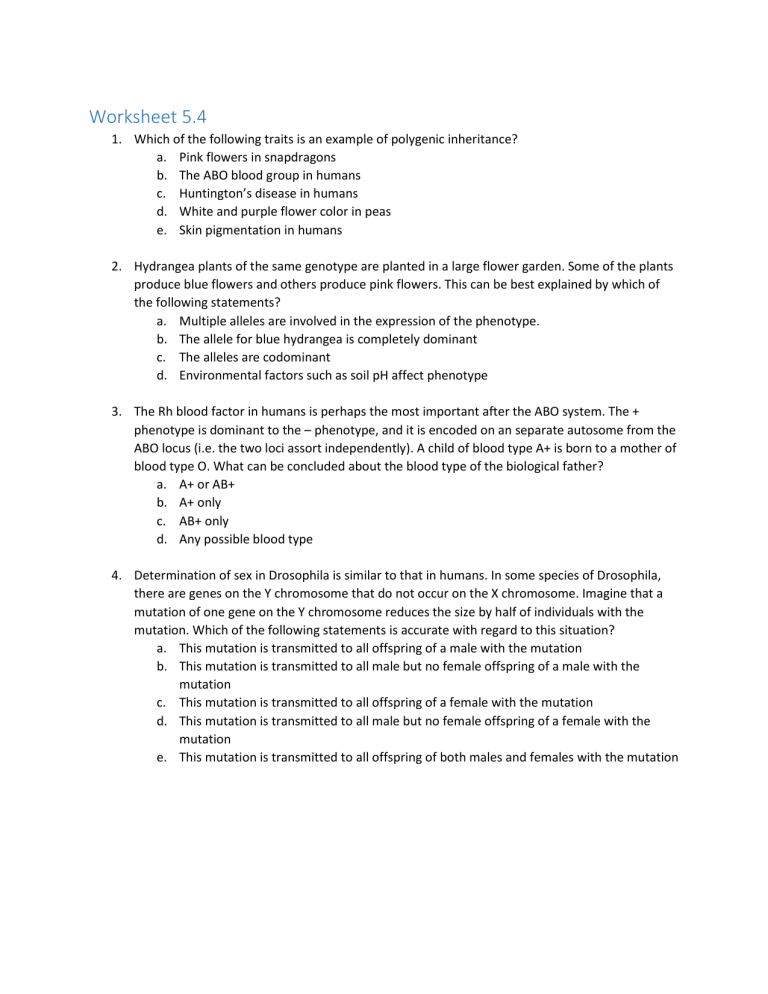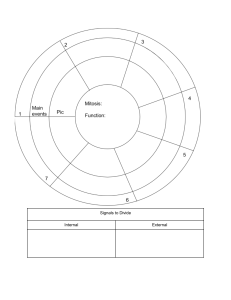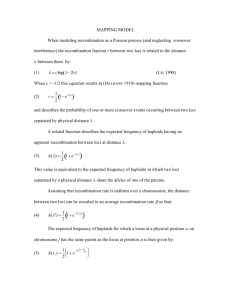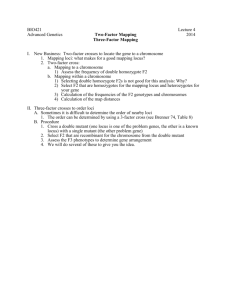
Worksheet 5.4 1. Which of the following traits is an example of polygenic inheritance? a. Pink flowers in snapdragons b. The ABO blood group in humans c. Huntington’s disease in humans d. White and purple flower color in peas e. Skin pigmentation in humans 2. Hydrangea plants of the same genotype are planted in a large flower garden. Some of the plants produce blue flowers and others produce pink flowers. This can be best explained by which of the following statements? a. Multiple alleles are involved in the expression of the phenotype. b. The allele for blue hydrangea is completely dominant c. The alleles are codominant d. Environmental factors such as soil pH affect phenotype 3. The Rh blood factor in humans is perhaps the most important after the ABO system. The + phenotype is dominant to the – phenotype, and it is encoded on an separate autosome from the ABO locus (i.e. the two loci assort independently). A child of blood type A+ is born to a mother of blood type O. What can be concluded about the blood type of the biological father? a. A+ or AB+ b. A+ only c. AB+ only d. Any possible blood type 4. Determination of sex in Drosophila is similar to that in humans. In some species of Drosophila, there are genes on the Y chromosome that do not occur on the X chromosome. Imagine that a mutation of one gene on the Y chromosome reduces the size by half of individuals with the mutation. Which of the following statements is accurate with regard to this situation? a. This mutation is transmitted to all offspring of a male with the mutation b. This mutation is transmitted to all male but no female offspring of a male with the mutation c. This mutation is transmitted to all offspring of a female with the mutation d. This mutation is transmitted to all male but no female offspring of a female with the mutation e. This mutation is transmitted to all offspring of both males and females with the mutation 5. Imagine a species with three loci thought to be on the same chromosom. The recombination rate between locus A and locus B is 35%, locus B and locus C is 33%, and locus A and locus C is 2%. Predict the arrangement of these genes, in order, on a chromosome. a. A, B , C b. B, A, C c. C, A, B d. A, C , B e. C, B, A 6. In Drosophila white eyes are due to an X-linked recessive allele (Xw). Describe genetic cross that could result in white-eyed female Drosophila. a. No possible cross b. White-eyed females with red-eyed males c. Heterozygous red-eyed females with white-eyed males d. Heterozygous red-eyed females with red-eyed males 7. Which statement best describes the relationship between recombination frequency and the physical distance of genes on chromosomes? a. There is no relationship. All genes have random recombination frequencies. b. There is no relationship. All genes have the same, fixed recombination frequencies. c. The farther apart two genes are, the higher the recombination frequency d. The closer together two genes are, the higher the recombination frequency 8. In tomatoes, a heterozygous plant with yellow flowers and red fruit is crossed with a recessive plant having white flowers and yellow fruit. The following distribution of offspring is observed: Yellow flowers, red fruit 42.5% White flowers, yellow fruit 42.5% Yellow flowers, yellow fruit 7.5% White flowers, red fruit 7.5% What conclusion can be made regarding the loci for flower color and fruit color? a. The loci may be on the same chromosome more than 50 map units apart, or they may be on separate chromosomes b. The loci are on separate chromosomes c. The loci are on the same chromosome, at an unknown distane from each other d. The loci are on the same chromosome 15 map units apart 9. In tomatoes, a heterozygous plant with purple stems and normal leaves is crossed with a recessive plant having green stems and broad leaves. The following distribution of offspring is observed: Purple stems, normal leaves 25% Green stems, broad leaves 25% Purple stems, broad leaves 25% Green stems, normal leaves 25% What conclusion can be made regarding the loci for flower color and fruit color? e. The loci may be on the same chromosome more than 50 map units apart, or they may be on separate chromosomes f. The loci are on separate chromosomes g. The loci are on the same chromosome, at an unknown distane from each other h. The loci are on the same chromosome 15 map units apart 10. Which of the following diagrams best depicts the karyotype of a trisomy? a. b. c. d. 11. Nondisjunction can happen in either meiosis I or meiosis II. Consider an n + 1 gamete that is formed from nondisjunction and compare the origin of the extra (+1) chromosome between the two types of nondisjunction. Select the best comparative statement. a. There is no inherent difference between the two b. The +1 chromosome resulting from meiosis I nondisjunction was a homolog of its partner, while that from meiosis II was a sister chromatid of its partner. c. The +1 chromosome resulting from meiosis I nondisjunction was a sister chromatid of its partner, while that from meiosis II was a homolog of its partner. d. The +1 chromosome resulting from meiosis I nondisjunction results in syndromes, while that from meiosis II does not. 12. The figure shows a pedigree chart for a family, some of whose memebers exhibit the dominant trait W. Affected individuals are indicated by a dark square or circle. What is the genotype of individual II-5? a. b. c. d. e. WW Ww ww WW or ww Ww or Ww 13. What is the likelihood that the offspring of IV-3 and IV-4 will have the trait? a. b. c. d. e. 0% 25% 50% 75% 100%




